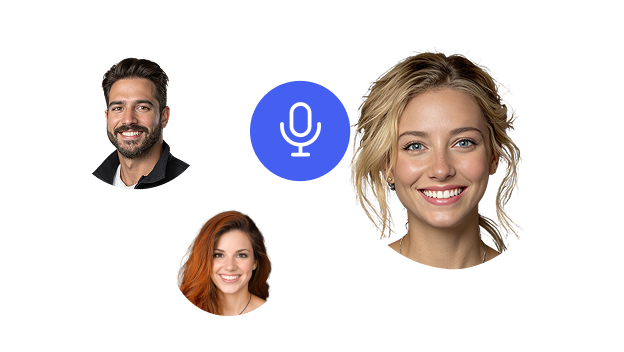What is a Voice Over?
A voice over is a production technique where a voice—often that of a professional voice actor—is used in radio, television, film, theatre, or other presentations. The voice over talent is off-camera and usually not seen. Voice overs are critical in media production as they breathe life into characters in animations, video games, and documentaries, provide narration in audiobooks and explainer videos, and offer professional appeal in podcast intros, among many other uses.
Steps to Create a Voice Over
Creating a great voice over requires a a series of steps. While it might seem daunting, it really is much easier than it looks. Especially with the introduction of AI voice overs.
- Script Preparation: Understanding the script is vital. It helps the voice actor grasp the message, tone, and the target audience of the voice over work.
- Vocal Warm-up: Before recording voice-overs, it's essential to warm up your vocal cords to avoid straining them and to ensure a smooth, clear voice sound.
- Enunciation Practice: Practice your diction—clear pronunciation of consonants, plosives, and vowel sounds. Good enunciation is key to a good voice over.
- Recording: This involves the actual recording of the voice over. It's done in a recording studio or a home studio, using a suitable recording software.
- Editing: After recording, the audio file is edited to remove any mouth noises, background noise, and other unwanted sounds. This editing process is done using editing software.
- Mastering: This is the final step in the voice over creation process. Mastering audio involves balancing the various elements in the voice-over audio for a clean, quality sound output.
Equipment Needed for Voice Over Recording
Voice acting, particularly for beginners, requires some essential equipment for recording voice-overs:
- Microphone: A good quality condenser microphone is crucial for capturing a clear, quality sound.
- Pop Filter: This is used to reduce or eliminate 'popping' sounds caused by the impact of fast-moving air on the microphone during the pronunciation of plosives like 'p' and 'b'.
- Headphones: A closed-back headphone is ideal for monitoring your voice as you record.
- Acoustic Treatment: To minimize background noise and echo in your recording space, acoustic treatments such as foam panels are necessary.
- Audio Interface: This device connects your microphone to your computer, converting the analog signal from your microphone into a digital signal your recording software can manipulate.
- Recording Software: Also known as a digital audio workstation (DAW), this is where you record, edit, and master your audio.
Voice Overs with AI
The voice over industry is evolving with the advancement in technology. Today, AI voice-over is gaining popularity. AI voice generators can generate human-like voice overs using text to speech, which can be tweaked to match the desired emotion and tone. This functionality offers an alternative to traditional voice over methods, especially for explainer videos, tutorials, or other content that doesn't require a highly emotive human touch.
Pros and Cons of AI Voice Overs vs. Traditional Methods
AI voice overs offer several advantages, including lower pricing than hiring a professional voice actor, faster turnaround times, and flexibility in voice selection. However, they lack the emotional depth, nuance, and unique qualities that a professional voice talent can provide.
In contrast, traditional voice overs have a higher cost and require more time for production, but they offer a level of expressiveness that AI currently cannot match.
The biggest factor with traditional voice overs is the recording process. A voice actor has to speak into a microphone and getting a quality recording depends on the actor, the technique, the equipment, the studio, and the editing process. The capturing is key.
With AI voiceovers negate the entire capture process. Every take is a perfect take. And the cost of equipment and talent is zero.
Speechify Studio - Easy AI Voice Overs
Speechify Studio is an AI voice over platform, featuring over 1,000 AI text to speech voices in a wide range of languages, accents, and emotional tones. Whether you need lifelike narration, dynamic character voices, or localized audio, Speechify makes it simple to create professional-grade content. The platform also includes AI dubbing to seamlessly translate and voice videos in other languages, voice cloning to create a custom AI version of your own voice, and a voice changer to reshape existing recordings. From content creators to educators to businesses, Speechify Studio gives you all the tools to tell your story in any voice.




